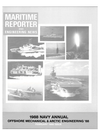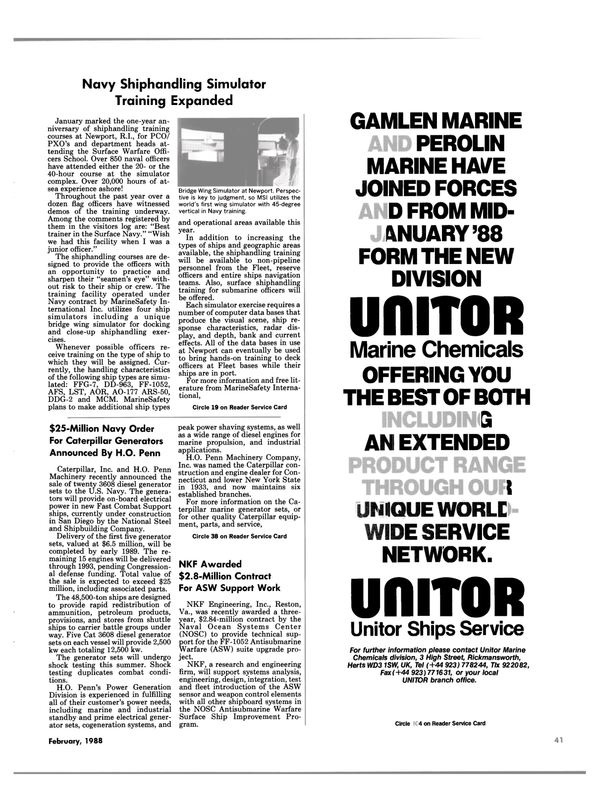
NAVY RESEARCH AND DEVELOPMENT
A Major Business Opportunity For Manufacturers, Technology And Engineering Firms International Maritime Associates (IMA) hs just issued a new report examining future business opportunities in the $9.5-billion Navy research and development program. In this report, there is a detailed assessment of each program element—describing the program, showing past and projected funding, naming key contractors and identifying near and long term program direction. This excerpt dealing with ship design shows the type of coverage provided for a specific program element.
This excerpt covers only the surface ship design part of the program with expenditures of between $60 to $100 million annually.
The entire 200+ page report is available from IMA for $550. It can be ordered by contacting: International Maritime Associates, Inc., 835 New Hampshire Avenue, NW, Washington, DC 20037; telephone: (202) 333-8501; (202/333-8504; telex: 64325 IMA.
Surface Ship Design And Engineering This program funds five phases of ship design: (1) exploratory development, (2) advanced concept studies, (3) feasibility studies, (4) preliminary design and (5) contract design and engineering development.
Efforts involve improvement in hull forms, concepts to reduce weight and cost, improved machinery integration, development of sybsystem technologies, etc.
Recent work in the first phase includes composite shaft testing, evaluation of low noise gears and model testing a flow smoothing propulsor.
Work in phases 2 through 4 includes the NATO frigate feasibility study, evaluation of foreign ship technologies and analysis of SWATH ship designs. Phase 5 work includes land testing the LSD 41 propulsion system, CRP design/ testing for the DDG 51 and oceanographic survey ship/AD 177 jumbo/ LSD 41CV designs.
Navy Managers: David Taylor Naval Ship R&D Center—Bethesda & Annapolis, MD; Naval Sea Sys- tems Command—Washington, DC; Naval Ocean Systems Center—San Diego, CA; and Naval Research Lab—Washington, DC.
Key Contractors: J.J. McMullen— Arlington, VA; M. Rosenblatt & Son—New York, NY; Designers & Planners—Arlington, VA; Gibbs & Cox—New York, NY; Adv. Marine Enterprises—Arlington, VA; JJH—Cherry Hill, NJ; George C.
Sharp—Arlington, VA; MAR Inc.— Rockville, MD; Westinghouse— Pittsburgh, PA; Advanced Technology— Reston, VA; Seaworthy Systems— Essex, CT; Tracor Hydronautics— Laurel, MD; Band Lavis— Annapolis, MD; Arctec—Columbia, MD; and NKF Engineering—Reston, VA.
Future Direction Exploratory research will include (1) flow-smoothing propulsor design and test, (2) metallic and composite sandwich panels, (3) blast damage algorithms, (4) liquid armor for ship protection, (5) explosive armor side protection systems, (6) GRP superstructure concepts, (7) SWATH structural research, (8) contrarotating homopolar components, (9) rotary diesels for propulsion and gensets, (10) superconducting components, (11) ceramic coating for marine gas turbines and (12) breadboard composite heat exchanger.
Design and engineering development work will include (1) Revolutionary Surface Combatant concepts, (2) Battle Force Combatant, (3) Fast Sealift Initiative SES, (4) Mission Essential Unit, (5) SWATH auxiliary ship design, (6) lightweight structure concepts, (7) ASW helicopter/ship interface, (8) improved missile UNREP technology and (9) demonstration of Arctic hovercraft, (10) NATO frigate design, (11) DUG 51 second flight block upgrade, (12) AGX/ AGOR oceanographic ships, (13) AE ammunition ship (may be cut), (14) LCAC block upgrade and (15) standard cargo/weapon elevator components.
Comments/Issues The Navy has begun a major high level study to improve surface ship design. The goal is to produce a family of combatant designs suited to the next century. In an initiating paper, the study group observed (1) basic ship design has not changed since World War II, (2) in contrast, revolutionary changes have occurred in combat systems development over the past 40 years (AEGIS, VLS, Tomahawk), (3) surface combatant acquisition costs have risen more than 480 percent over the past 30 years, (4) shipboard manning requirements are increasing, despite advances in automation, (5) payload/weight ratio has been decreasing—while overall displacement has been increasing and (6) cubic feet per man for habitability and personnel support spaces and storerooms is growing.
The Navy had requested $94.4 million for surface ship design and engineering RDT&E in FY 1988.
Congress provided $67.0 million—a cut of 29 percent. Showing that funding priorities are weighted in favor of submarine design and development, Congress added $100 million this year for advanced attack submarine design while cutting surface ship design efforts.
Read NAVY RESEARCH AND DEVELOPMENT in Pdf, Flash or Html5 edition of February 1988 Maritime Reporter
Other stories from February 1988 issue
Content
- Almerico to Manage Trinity's Mississippi Shipbuilding Operations page: 5
- New Swagelok Tube Fittings Incorporate Sanitary Flanges page: 5
- Mitsubishi's High-Speed Passenger Boat Promises New Era In Smooth Sailing page: 6
- New Emergency Marker Lights Described In Color Brochure From American Cyanamid Co. page: 6
- New Products From Furuno: Advanced FAP-50 Autopilot, And Weatherfax xWith A Twist' page: 8
- Canadian Shipbuilding And Ship Repairing Association (CSSRA) Becomes CMIA page: 9
- Cruise Ship Industry Spurs Construction in Italian Yards page: 10
- Fincantieri Converting Six Ferries Under $74.4-Million Contract page: 10
- Major U.S. Shipping Companies Form New Industry Association page: 11
- Aluminum Boats Constructing 138-Foot Detroit Diesel-Powered Luxury Dinner/Cruise Vessel page: 11
- Free N ew Color Brochure Features Dampa Products page: 11
- U.S. Opens Port Of Coos Bay To Polish Ship Repairs page: 12
- American Welding Society Announces Spring Welding Education Seminar Series page: 12
- Video Describes Port Design Process And Use Of Simulation page: 13
- Hagglunds To Acquire Dutch Crane Group page: 14
- 5 Canadian Consortiums Contend For $5-Billion Domestic Sub Project page: 15
- Ceramic Coatings Approved By ABS For Diesel Engine Use page: 15
- 7th International Symposium Offshore Mechanics And Arctic Engineering page: 16
- Marine coatings & corrosion control page: 20
- Grow Group, Inc. Announces Personnel Changes page: 24
- Converted Detroit Diesel-Powered Crewboat Includes Airliner Features For Passengers, Cargo page: 25
- Kim Hotstart Pre-Heating Systems Shrink Engine Idling Costs page: 25
- Robertson Autopilot Wins NMEA Honors page: 26
- FULL FUNDING FOR TWO NEW CARRIERS GIVES NAVY 46% INCREASE FOR SHIPBUILDING page: 29
- NAVY RESEARCH AND DEVELOPMENT page: 39
- Southern California Sections Of American Society Of Naval Engineers To Hold Centennial Symposium page: 40
- Navy Plans To Develop ASW Minisubmarine Fleet At Cost Of $5 Billion page: 40
- Navy Shiphandling Simulator Training Expanded page: 41
- $25-Million Navy Order For Caterpillar Generators Announced By H.O. Penn page: 41
- MAJOR NAVY CONTRACTS page: 42
- Navy Secretary Webb Guest Speaker At Joint Meeting Of Propeller Club-U.S.M.M.A. Alumni page: 42
- Ingalls Awarded Navy Contract Worth $378.7 Million To Build Third LHD Ship page: 44
- Bird-Johnson Promotes Ike L. Svensson To GM-Seattle Operations page: 47
- MAN GHH Merges Crane Subsidiaries page: 50
- Fjellstrand Delivers New Design, High-Speed 200-Passenger Ferry page: 51
- Si-Tex Offers Budget Radiotelephone; Reintroduces EZ-7 Loran-C Receiver page: 51
- American Bureau Of Shipping— A 'Class Act' For Over 125 Years page: 52
- Raytheon Introduces New R61 Rasterscan Radar page: 54
- Cummins-Powered 'Traktor Jet' Gives Workboats Unprecedented Thrust page: 54
- Cummins Announces Availability Of New XA' Series Diesel Engines page: 55
- Westmark Completes Acquisition Of Tracor page: 55
- Furuno Introduces New High Resolution Color Radar page: 56
- McDermott Joint Venture Awarded Contract Worth More Than $100 Million page: 56
- New Container Liner Bags Cut Liquid Carriage Costs page: 56
- Bender Posts Successful Recovery From Chapter 11 page: 57
- Spar Associates Awarded Systems Contract By Halifax-Dartmouth page: 61
- Free Brochure On Marine Technical Services Offered By Clyde Leavitt, Inc. page: 62
- EES Corporation Offers Brochure On 'Omnipure' Sewage Treatment Plants page: 62
- Wartsila Diesel Presents A New Auxiliary Engine, The Vasa 2 2 / 26 page: 69


